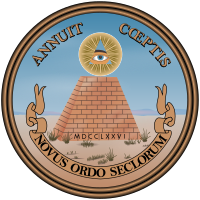
The New World Order (NWO) is a term used in several conspiracy theories which hypothesize a secretly emerging totalitarian world government.[3][4][5][6][7] The common theme in conspiracy theories about a New World Order is that a secretive power elite with a globalist agenda is conspiring to eventually rule the world through an authoritarian one-world government—which will replace sovereign nation-states—and an all-encompassing propaganda whose ideology hails the establishment of the New World Order as the culmination of history's progress. Many influential historical and contemporary figures have therefore been alleged to be part of a cabal that operates through many front organizations to orchestrate significant political and financial events, ranging from causing systemic crises to pushing through controversial policies, at both national and international levels, as steps in an ongoing plot to achieve world domination.[3][4][5][6][7]
Before the early 1990s, New World Order conspiracism was limited to two American countercultures, primarily the militantly anti-government right, and secondarily the part of fundamentalist Christianity concerned with the eschatological end-time emergence of the Antichrist.[8] Academics who study conspiracy theories and religious extremism, such as Michael Barkun and Chip Berlet, observed that right-wing populist conspiracy theories about a New World Order not only had been embraced by many seekers of stigmatized knowledge but also had seeped into popular culture, thereby fueling a surge of interest and participation in survivalism and paramilitarism as many people actively prepare for apocalyptic and millenarian scenarios.[4][6] These political scientists warn that mass hysteria over New World Order conspiracy theories could eventually have devastating effects on American political life, ranging from escalating lone-wolf terrorism to the rise to power of authoritarian ultranationalist demagogues.[4][6][9]
- ^ Lewis and Short, A Latin Dictionary
- ^ Cite error: The named reference
GreatSeal.comwas invoked but never defined (see the help page). - ^ a b Camp, Gregory S. (1997). Selling Fear: Conspiracy Theories and End-Times Paranoia. Commish Walsh. ASIN B000J0N8NC.
- ^ a b c d Berlet, Chip; Lyons, Matthew N. (2000). Right-Wing Populism in America: Too Close for Comfort. Guilford Press. ISBN 1-57230-562-2.
- ^ a b Goldberg, Robert Alan (2001). Enemies Within: The Culture of Conspiracy in Modern America. Yale University Press. ISBN 0-300-09000-5.
- ^ a b c d Barkun, Michael (2003). A Culture of Conspiracy: Apocalyptic Visions in Contemporary America. University of California Press; 1 edition. ISBN 0-520-23805-2.
- ^ a b Fenster, Mark (2008). Conspiracy Theories: Secrecy and Power in American Culture (2nd ed.). University of Minnesota Press. ISBN 978-0-8166-5494-9.
- ^ Berlet, Chip (September 2004). "Interview: Michael Barkun". New Internationalist. Retrieved 1 October 2009.
- ^ Blankstein, Andrew; Williams, Pete (1 November 2014). "Sources: Alleged LAX gunman had 'new world order' conspiracy tract". NBC News. Retrieved 10 July 2014.